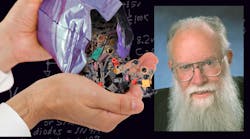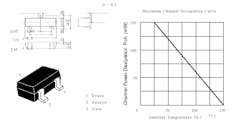This article is part of Bob Pease's Floobydust series found in the Electronic History section of our Series Library.
Well, finally I have gotten enough good material to put together this column of “Floobydust” or, in other words, “Miscellaneous.”
• One guy faxed me some info on JFETs. He found some Hitachi FETs, 2SK1070s (Fig. 1), with just 18.8 mV per octave of Ids, when operated at a small (sub-threshold) bias. These are some of the hot FETs that have very high gm running at high currents, as well as low noise. That's not exactly 18 mV per octave, but it's pretty close!
Also, I received a number of articles sent by Dr. Michael Alles of Ibis Technology Corp., 32A Cherry Hill Dr., Danvers, MA 01923. He pointed out that while ordinary MOSFETs have fairly good gm (perhaps 27 mV per octave), if the current density is rather low and the gate oxide is very thin, you can get even better gm per mA with SOI (Silicon On Insulator) FETs. Some of those examples1,2,3 indicate that up to 18 mV per octave is possible. So if you need a FET to give really excellent gm per mA, the SOI guys may be able to provide it.
Now we have a pretty good understanding of why MOSFET rate of change of current is usually worse than 18 mV per octave. (This corresponds to the case of gm/id falling before low 38.6 at room temp.) Unfortunately, we have yet to see an explanation of why the gm/ id of a JFET falls below 38.6, by any particular extent, as a predictable function of any doping or geometrical considerations.
• I did get magazine articles and clippings from several guys about the “Spacistor,” invented in 1957 by Raytheon. The best info came from Mr. Burch of Austin, Texas, who sent in a clipping from the Sept. 1957 Electronic Industries & Teletech magazine.
The Spacistor was NOT a FET. It was a single p-n diode, with a reverse bias, and with two point contacts made into the space-charge region. One of the points was supposed to inject carriers into the region, and the other contact was supposed to modulate the current flow with high bandwidth. When you think about it, it was NOT going to be easy to drop two little contacts into the narrow space- charge region. The Spacistor never had a chance, competing with modern planar transistors and ICs. Raytheon never broke even on that project.
• I got a neat, simple letter from Dennis Feucht of Townville, Pa. He sent me a simple sketch of a dead zone's characteristics compared to a hysteresis curve, and the statement “dead zone £ hysteresis.”
I got in touch with Dennis, and we debated this. I admitted I was perhaps guilty of a little sloppy thinking, but not too far out. A dead zone is just a nonlinear transfer curve that has no memory, no energy storage. A hysteresis curve typically consists of a dead zone plus some energy storage (an inductor or a capacitor) or perhaps a mechanical position error. So while a dead zone is not identical or equal to a hysteresis curve, it can be fairly closely related—it can be made from one. Thanks for requiring me to clarify this, Dennis.
• Recently, I got an anonymous letter from “a Fellow Engineer” who thinks that I have wasted 2.9 years of my life driving 106 miles in my VWs. “Oh, I'm sure you think about work while you're driving, but if you do, you are probably endangering your life and the lives of your fellow commuters.” How does he know that? Over those 106 miles I've proven that I can think and drive safely at the same time. But, that doesn't mean I'm not thinking some terrifying, mean, nasty, dangerous thoughts.
“I can't think of a more wasteful/inefficient way for a brilliant and inciteful (now that's a Freudian slip!—RAP) person like yourself to waste your life.” Well, if Mr. Fellow Engineer had been thoughtful enough to include his address, I would have asked him how many hours a week he spends watching TV. That's a pretty wasteful/inefficient way to spend your life, in my opinion. Besides, the pictures are better on radio, as those of us who commute will agree.
“I can't help but feel sorry for you Bob, as well as others who are trapping themselves in the habit of long distance commuting.” Well, I like to live in San Francisco, and I like to work in Silicon Valley. I can't help but feel sorry for people who insist on a short commute, and are trapping themselves into living close to where they work, or working close to where they live.
I can live where I prefer, and commute to the place where I like to work. My commute time is within a couple minutes of what it was 15 years ago. Sometimes more, sometimes less. I know people who commute 8 miles and spend almost as much time as I do poking along in stop-and-go traffic. That's not my idea of fun.
It's also true that I like to drive, and I like to ride while my wife or sons drive. Sometimes we drive a lot on vacations. Maybe Mr. Fellow Engineer does not. Since he left no address, I can’t ask him how many miles per year he drives.
• Another writer asked, “You propose it’s a good idea to practice double-clutching your shifts, so you will be able to shift without the clutch when your clutch-cable breaks. But if you did not double-clutch, perhaps the cable would last twice as long? Good question! Actually, the cable's life seems to tolerate an almost infinite number of shifts while it is new and well-lubricated, but when the grease wears off and it gets a little rusty, it appears to wear rapidly. So if I didn't double-clutch, the cable would not last much longer
• I also would like to comment on a related topic: I pay extra for my auto insurance because I drive a lot of miles, which I think is absurd because I've had VERY FEW accidents in 40 years of driving. It's well known that people who drive few miles have more accidents per mile. People who drive a lot of miles are better drivers and have fewer accidents per mile. So why do the insurance companies rip us off? Because they can....
• While we are on the topic of cars, I want to mention a neat machine described in a data sheet sent to me by Professor C. Zardini of the University of Bordeaux, France. It is a hybrid car (gasoline-electric with NiCd batteries) made by Irmscher of Germany4. The good news is that its little 0.09-liter engine can put out 9.5 hp and only needs to run 1/3 of the time. The gas mileage is about 140 mpg. The batteries, about 770 lb. of NiCds, can store 40 Ah at 390 V, which is enough to provide a range of about 70 or 80 miles at 48 mph without starting the little engine. Now, that's a very efficient car, since few cars can run on 3 hp at cruising speed.
Now, the not-so-good news: First you have to pay $24,000 for the car. Then you have to lease the batteries at $3.50 per day. In Europe, where gas costs $3 or $4 per gallon, this is not a big winner. But it may save you a little money if you drive many miles per day, so that the $3.50 per day of battery rental is spread over a lot of usage. With the specs given, the car won't be very cost-effective here in the States, where gas is cheap. But it does indicate the feasibility of a high-tech hybrid car with a small engine. Maybe in a few years, a car like this will be affordable.
But, come to think of it, let's say this car makes economic sense only if you drive more than 40 or 50 miles per day. That makes sense only if you get on an Autobahn. And the cars on the Autobahns cruise at 70 mph, minimum. I wonder if this little 9-hp car can keep from being overrun by faster VW Beetles out on the Autobahn? I don't think it can make 140 mpg at 80 mph.
It also states that the little engine, whirring along at a constant 9000 rpm, is only rated to run 500 hours, or about 60,000 miles, before it should be replaced. Maybe you get some good specs from running a 90-cc engine at 9000 rpm, but in the long run, a little 0.16-liter engine at 6000 or 7000 rpm might live longer and be more economical. Note, the 9000 rpm is a constant speed, making for optimum emissions and efficiency and the simplest energy transfer from the alternator into the batteries. That sounds like some pretty good sharp-pencil engineering! ! Now if they can just figure out how to build and sell it for $12,000....
Read What's All This Floobydust Stuff, Anyhow? (Part 4)
All for now. / Comments invited!
RAP / Robert A. Pease / Engineer
Address:
Mail Stop D2597A National Semiconductor
P. O. Box 58090
Santa Clara, CA 95052-8090
References:
1. S. Parke, C. Hu, and P. Ko, “Bipolar-FET Hybrid-Mode Operation of Quarter-Micrometer SOI MOS- FETs," IEEE Electron Device Letters, May 1993, pp. 234-236.
2. J. Colinge et ah, “Silicon-on-Insula- tor ‘Gate-All-Around Device,' " IEDM ’90, p. 25.4.1- 25.4.4.
3. K. Suzuki et. al., “Scaling Theory for Double-Gate SOI MOSFETs," IEEE Transactions on Electron Devices, Dec. 1993, pp. 2326-2329.
4. Irmscher Automobilbau GmbH, Bahnhofstrasse 79, D-73630 Remshal- den-Grunbach, Germany; phone: 00- 49-7151/ 9 71-0.


